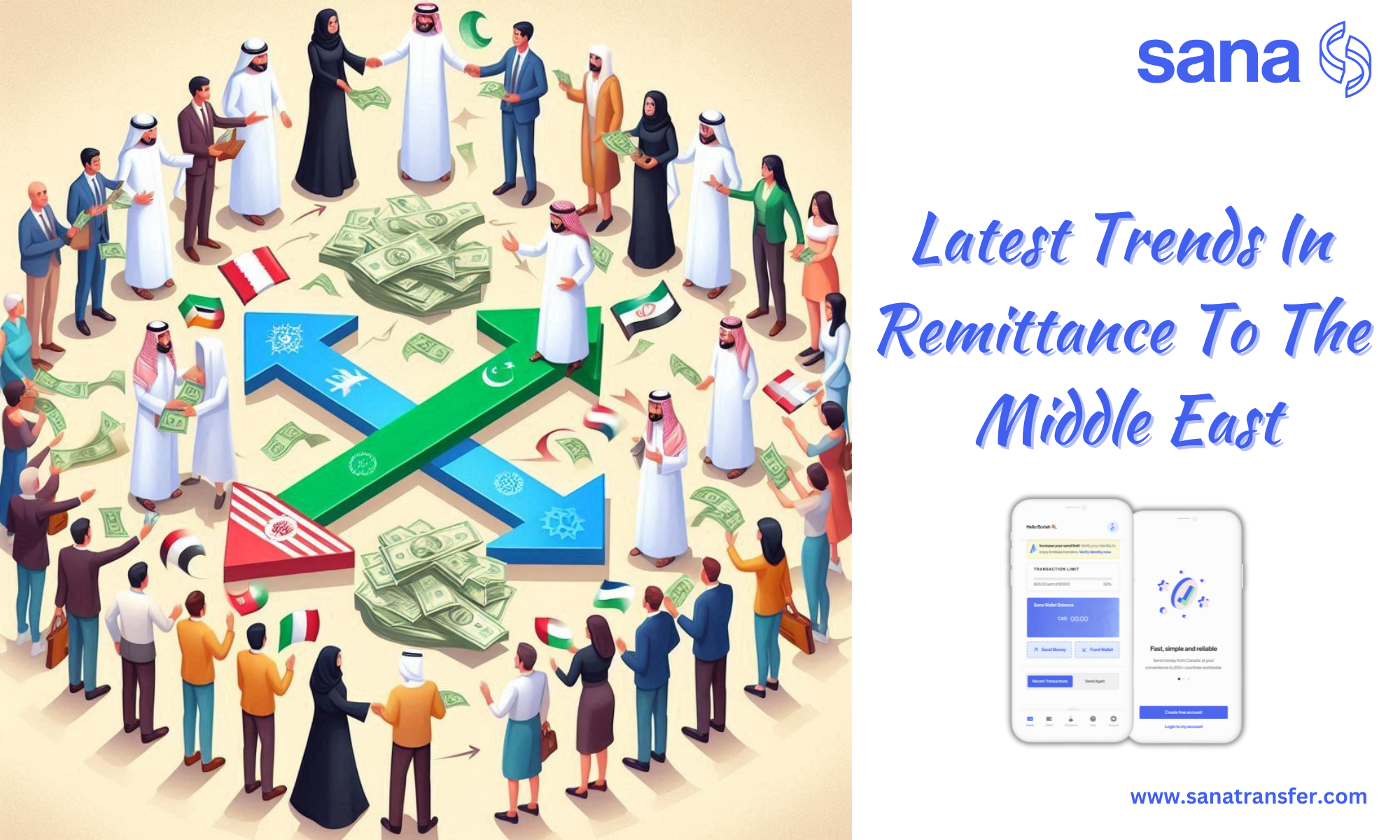Latest Trends In Remittance To The Middle East

Remittances, money sent home by migrant workers, act as a vital lifeline for many families in the Middle East. These funds contribute significantly to household income, often exceeding 5% of a country's GDP. They help cover basic needs like food and education, and can even fuel investments in businesses or homes.
However, it's important to note that recent years, particularly 2023, saw a slowdown in remittance growth compared to previous years. In 2023, the Middle East and North Africa had a 15% decrease in remittances to $55 billion, mostly as a result of a large reduction in remittances to Egypt, as remittances were most likely shifted to unofficial routes due to the difference between official and parallel foreign exchange rates another reason is the fact that sending remittances remains too costly, taking up 6.4% of the money being sent.
In this post, we shall closely examine the latest trends in remittance to the Middle East.
Factors Affecting Remittance Trends In The Middle East
As explained above, remittances to the Middle East, have experienced a slowdown in recent years. While these financial flows historically displayed steady growth, 2023 saw a noticeable decline. Let's delve into the factors influencing this trend.
A. Impact of Global Events (2023 Slowdown)
Experts believe that the reason for the slowdown in remittances to the Middle East is due to a number of factors including:
Slower Economic Growth in High-Income Countries
The economic performance of migrant-hosting countries directly impacts remittance flows. A slowdown in these nations, like the one witnessed in 2023, translates to tighter budgets and potentially fewer job opportunities for migrant workers. This can lead to decreased earnings and a reluctance to send back as much money.
Read Also: Remittances: A Powerful Force for African Development
Fluctuations in Oil Prices and Currency Exchange Rates
The Middle East is heavily reliant on oil exports. When oil prices drop, it affects the region's overall economic health. As the world slowly moves away from the use of fossil fuels to cleaner, renewable energy, the oil market suffers affecting the Middle East immensely.
Additionally, fluctuations in currency exchange rates can significantly impact the value of remittances received. A strong sending country currency relative to the receiving country's currency translates to a lower value for families receiving remittances, potentially leading to a decrease in overall remittance volume.
B. Regional Variations
Regional variations also affect remittance trends in the Middle East. The recent slowdown wasn't uniform across all remittance-receiving regions.
Strong Growth in Latin America & Caribbean (2023)
In contrast to the Middle East, remittance flows to Latin America and the Caribbean displayed robust growth in 2023. This can be attributed to factors like a more diversified economy in some Latin American countries, making them less susceptible to global oil price fluctuations. Additionally, demographic factors, such as a larger migrant population compared to the Middle East, might be contributing to the sustained remittance flow.
Decline in Middle East & North Africa (2023)
While the reasons for the decline in the Middle East and North Africa are complex, the factors mentioned above, particularly the slowdown in some high-income migrant-hosting countries and the volatility of oil prices, likely played a significant role. Additionally, regional political instability and ongoing conflicts might be discouraging some migrant workers from sending money back home.
Read Also: Emerging Technologies In Global Money Transfer
Understanding these factors is crucial for policymakers in the Middle East to develop strategies that can mitigate the impact of external economic fluctuations and strengthen remittance flows, a vital source of income for the region.
Rise of Digital Remittances
While checking out the latest trends in remittance to the Middl east, one cannot not notice the rise of digital remittances. Globally, there is a surge in digital money transfer channels replacing traditional offline methods. This trend is also impacting remittances flowing into the Middle East, offering both opportunities and challenges.
At the heart of this change lies the increased penetration of mobile phones and the growing popularity of online shopping. With smartphones becoming ubiquitous, particularly in the Middle East where mobile phone usage is high, sending and receiving money has become a more accessible and convenient process.
Additionally, the rise of online shopping platforms has further fueled the demand for digital remittances as people increasingly need to transfer funds for cross-border transactions.
This shift towards digital remittances offers several key benefits for both senders and receivers including:
- Convenience: Removing the old trend of visiting money transfer agents, giving users the opportunity to initiate transfers anytime, anywhere, through a user-friendly mobile app or website interface.
- Speed: Digital transfers are significantly faster than traditional methods. Money can reach recipients within minutes, compared to the days or even weeks it could take with offline channels.
- Security: Reputable digital remittance providers implement robust security measures, including encryption and fraud prevention tools, to ensure the safety of users' financial information and transferred funds.
However, it's important to acknowledge that the Middle East is still in a transitional phase when it comes to digital remittances. While the trend is undeniable, some challenges remain. Building trust in digital platforms, particularly among older generations or those residing in rural areas with limited internet access, requires ongoing efforts from remittance service providers. Additionally, ensuring user-friendly interfaces and multilingual support are crucial for wider adoption across the region.
Despite these challenges, the rise of digital remittances presents a significant opportunity for the Middle East. By embracing this new landscape and fostering an environment conducive to digital financial services, the region can experience even greater efficiency, speed, and security in sending and receiving remittances, a vital source of income for many families.
Read Also: Optimising International Money Transfers As Eid al-Adha Approaches
Purpose-Driven Remittances: One Of The Latest Trends In Remittance To The Middle East
Traditionally, remittances have focused on sending cash home to support basic needs. However, a new trend is emerging in the Middle East: purpose-driven remittances. This shift reflects a growing demand for services that extend beyond simple cash transfers, catering to the evolving needs of migrant workers and their families.
Moving Beyond Cash
Migrants often face challenges managing their finances across borders. This is particularly true for unbanked expats who lack access to traditional financial services. Purpose-driven remittances address this gap by offering a wider range of options.
One example of purpose-driven remittances is the rise of prepaid digital vouchers. These vouchers allow migrants to directly top up the mobile airtime or data plans of their families back home. This ensures that the money sent is used for its intended purpose, especially crucial for families relying on mobile communication to stay connected.
Financial Control and Empowerment
Purpose-driven remittances offer several benefits for both senders and receivers:
- Increased Control: With options like prepaid vouchers, senders gain greater control over how their money is spent, ensuring it directly addresses specific needs.
- Financial Empowerment: This targeted approach can empower families to manage their finances more effectively, potentially fostering better budgeting habits and long-term financial planning.
- Enhanced Convenience: Digital platforms offering these services often provide user-friendly interfaces allowing for easy selection and purchase of specific vouchers, simplifying the remittance process.
However, the adoption of purpose-driven remittances faces challenges. Collaboration between financial institutions, remittance service providers, and local businesses is crucial to expand the options available and ensure wider accessibility across the region. Additionally, educating both senders and receivers about these new services will be key to driving their adoption.
The rise of purpose-driven remittances presents an exciting opportunity for the Middle East. By embracing these innovative solutions, the region can empower migrant workers and their families, fostering a future where remittances contribute not just to immediate needs, but also to long-term financial security and well-being.
The Future of Remittances in the Middle East
We have checked out the latest trends in remittance to the Middle East, now let us focus on the future of these trends. While 2023 witnessed a slowdown in remittance flows to the Middle East, experts predict a moderate rebound for 2024. This anticipated growth underscores the enduring importance of remittances as a lifeline for many families in the region.
However, to ensure continued and sustainable growth, a focus on facilitating safe, affordable, and efficient transfers will be paramount.
Read Also: Optimising Money Transfer to War-Torn Countries
A Return to Growth
The projected rebound in 2024 suggests a potential recovery from the economic factors that contributed to the previous slowdown. This could be driven by a stabilization of oil prices, a return to pre-slowdown growth rates in high-income migrant-hosting countries, and potentially, a decrease in regional tensions.
Building a Better Remittance Ecosystem: To solidify this growth and ensure the long-term well-being of remittance recipients, several key areas require focus:
- Promoting Digital Adoption: As discussed earlier, the continued embrace of digital remittance platforms offers significant advantages. Governments and financial institutions can play a crucial role in promoting digital literacy and building trust in online services, particularly among unbanked populations.
- Ensuring Competitive Costs: Remittance fees can eat into a significant portion of the funds sent. Encouraging competition among remittance service providers can help drive down costs, ensuring more money reaches its intended recipients.
- Regulatory Frameworks: Developing robust regulatory frameworks that prioritize consumer protection and combat money laundering will foster a secure and transparent remittance environment.
Looking Ahead
Technological advancements, such as the potential of blockchain technology to further streamline and secure cross-border transfers, offer exciting possibilities for the future of remittances. By embracing these innovations and prioritizing the needs of both senders and receivers, the Middle East can create a robust and efficient remittance ecosystem that empowers its people and fuels continued economic growth.
The future of remittances in the Middle East appears promising. With a focus on growth, efficiency, and inclusivity, this vital financial lifeline can continue to play a transformative role in the lives of millions across the region.
Conclusion
Now that we have checked out the latest trends in remittance to the Middle East; we can affirm that remittances remain a cornerstone of economic stability and social well-being for many families in the Middle East. The recent slowdown in remittance growth highlights the vulnerability of these financial flows to external factors. However, a projected rebound in 2024 coupled with ongoing efforts to promote digital adoption, competitive costs, and robust regulations indicates a promising future.
Looking ahead, advancements like blockchain technology hold the potential to further revolutionize remittances, offering even greater speed, security, and transparency. By embracing innovation and prioritizing the needs of senders and receivers, the Middle East can create a future where remittances are not just a source of financial support, but also a tool for empowerment, fostering long-term financial security and paving the way for a more prosperous region.
Need affordable, fast and secure remittances to the Middle East from Canada? trust SanaTransfer as your one sure partner. Download our app for Android and iOS or sign up on our website to begin.
